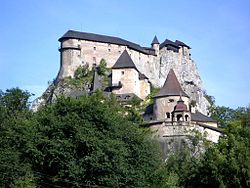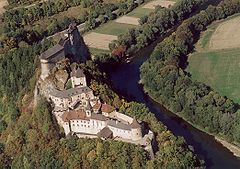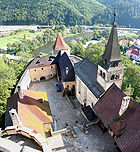- Orava (castle)
-
Orava Castle (Hungarian: Árva vára, German: Arwaburg, Slovak: Oravský hrad) is situated on a high rock above Orava river. It is considered to be one of the most beautiful castles in Slovakia. The castle was built in the thirteenth century. Many scenes of the 1922 film Nosferatu were filmed here, although until recently it was thought to have been shot in Transylvania.
Orava Castle stands on the site of an old wooden fortification, built after the Tartar invasion of 1241. Its history since then reveals a familiar pattern of construction, destruction, reconstruction, fire, various ownerships and territorial squabbles. The original design was in Romanesque and Gothic style; it was later reconstructed as a Renaissance and Neo-Gothic structure, hugging the shape of the 520-metre spur on which it perches.
The mining magnate Thurzo family, who took charge in the mid 16th century, were responsible for a great deal of rebuilding work, although its present form was not finalised until 1611. It burnt down again in 1800, after which the Pálffys occupied the castle. And then, after a period of dilapidation and World War II, the castle became a national monument.
Contents
Origins
The natural rock formation known as "castle cliff" – a limy spur 112 meters (367 ft) high, surrounded by the Orava River and its right tributary stream Racova – has been inhabited since primeval times. During its history a wooden rampart became a strong walled castle of which the first written record dates back to 1267. At that time only the ground floor was built of stone, while the upper floors were made of wood.
In 1370 as part of the Hungarian Kingdom the castle became the center of Árva county. A tetrahedral multi-story towerntury was built here in the 14th century, probably on older foundations, as a donjon - the place of "last defense" within the castle. After 1474, King Matthew gave orders to build a square and a residence-wing in the Middle Castle. The buildings were situated in front of the castle. In 1534 John of Dubovec obtained the castle and became head of the county. He started to rebuild the castle and to make new fortifications. He ordered the building of a half-round tower in the Upper Castle that in 1539 was followed by two large round fortifications for cannons in the Middle Castle. The middle platform was also configured for cannon firing. In the years 1539 - 1543 John of Dubovec built a five-story palace in the empty space between the tower and the stone wall of the Upper Castle. The Turkish threat was the reason for building these new fortifications. A new gate with a ditch and drawbridge in the Lower Castle was completed in 1543. The Tower of the Archives was built against the castle walls.
Sixteenth to Eighteenth Centuries
After the death of John of Dubovec, his heirs quarreled over the inheritance and the situation became so bad that the castle even became a store-house. It was paid for by the mine owner Ferenc Thurzó. A lot of building activity took place at the castle following this time period. The wooden stairs in the Upper Castle were replaced by stone stairs. The same was done to the stairs between the Middle and the Upper Castle with the drawbridge. A cellar was also dug out of the stone of the castle court and a one-story residence-wing was built in the Lower Castle near the west wall.
György Thurzó also carried out some important repairs. One of the first was the building of a tunnel between both castle gates, above which was formed a large terrace. After this was all done he moved the living-quarters and the building of the Chapel started using parts of some old architecture. The interior furnishing of the Chapel was later arranged in a taste which suited the new owners of the Castle. One of the most well-known features is the Renaissance grave tomb of György Thurzó from the beginning of the 17th century and the Baroque altar from 1751 - 1752.
Disuse, fire and the museum
After the death of Erzsébet Czobor, the widow of György Thurzó, the castle became the property of Thurzó's daughters, who entrusted its administration to an elected administrator. Because of changes in politics, society and the economy, the castle gradually lost its important functions. Only a few clerks stayed on and the uninhabited and disused parts of the castle gradually deteriorated. The greatest catastrophe affected the castle in 1800, when a gigantic fire destroyed all the wooden parts of the castle. Some objects from the Lower Castle were recovered after the fire because they had been cover by the shingles. However, the objects from the Middle and Upper Castle were not reconstructed until 1861.
To find a use for the historical object, Ödön Zichy, the administrator of the property (Kompossesorat), organized a foundation which had the aim of founding a regional museum of Orava. The first exhibition took place at the Thurzo Palace in 1868. Nowadays, the Orava Museum is one of the oldest in Slovakia. Its most attractive expositions are those of the Castle Chapel, the Knights' Room, and several rooms with period-style furnishing. Further highlights include the Painting Gallery, the Weapon room, and the scientific, ethnographic and archaeological collections.
Restoration
At the turn of the twentieth century, the castle became severely run down. Joseph Pálffy organized major repairs. Walls were fortified with iron bars in the area of the third gate and in the tunnel. Pálffy also set himself the task of restoring the interior. Some rooms received wooden tiles and period-style furnishing. In the Knights' Room Joseph Pálffy had wall paintings restored and completed by the German painter Maximilian Mann from Munich.
After the Second World War Orava Castle was again generously renovated, and it was declared a national cultural monument in 1953.
External links
- Orava Castle Museum Official Website
- Orava Castle from Slovak Heritage
- Orava Castle Tour Information from Muzeum.sk
- Photographs of Orava Castle from Muzeum.sk
- Christmas at Orava Castle
- http://www.oravskyhrad.sk/
- Slovak Spectator - Orava Castle: Dradcula´s Slovak residenceCoordinates: 49°15′42″N 19°21′29″E / 49.26167°N 19.35806°E
Categories:- Castles in Slovakia
- Dracula
Wikimedia Foundation. 2010.



